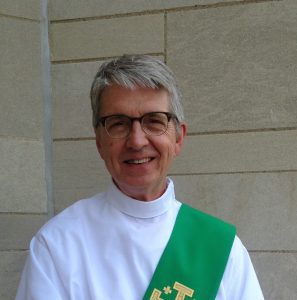 From the desk of Deacon Dave Etters…
From the desk of Deacon Dave Etters…
“Men of Galilee, why are you standing there looking at the sky? This Jesus who has been taken up from you into heaven will return in the same way as you have seen him going into heaven.” (Acts 1:11)
It is customary for the winning driver of the Indianapolis 500 auto race to be adorned with a flowered wreath. Next, in Indy tradition, he and his race team kiss the bricks on the track and drink from a bottle of milk — which is typically dumped on their heads. Afterward, the celebration concludes with the famous victory lap around the track, a ‘slo-mo’ exclamation point to that which has been accomplished.
St. John the Beloved, an eye witness at the foot of the cross, records that after Jesus received a sponge of vinegar said, “It is finished,” and then bowed his head and died. In his obedience to death, death on the cross, our redemption was won. The victory over sin and death was manifested Easter morning in his resurrection and subsequently in his post-resurrection appearances over 40 days. And then Jesus left his disciples and ascended, returning to the Father. While it might seem that the Ascension is a footnote to the resurrection or a ‘Jesus victory lap’, celebrating and triumphing in what he has accomplished, there is much more to this most important solemnity we observe today.
There are at least four principal goods that are unique to the Ascension of Jesus.
First. The Catechism states, “Christ’s Ascension marks the definitive entrance of Jesus’ humanity into God’s heavenly domain…” (CCC 665).
When God created Adam and Eve, they were to enjoy life in earthly paradise forever. However, through Adam’s sin, Original Innocence was lost and death came to all. But God turned that loss into something BETTER! Through the promised Redeemer a portal opened to a greater good, a heavenly paradise. As proclaimed in the Easter Exultet:
O truly necessary sin of Adam, destroyed completely by the Death of Christ!
O happy fault that earned so great, so glorious a Redeemer!
Consequently, when Jesus ascended to the Father in his humanity he prepared the way for the faithful to also enter the divine heavenly life in union with the Blessed Trinity.
Second. In his last discourse, Jesus told his disciples, “Nevertheless I tell you the truth: it is to your advantage that I go away, for if I do not go away, the Counselor will not come to you; but if I go, I will send him to you.” Because of his Ascension, the Holy Spirit was sent to us, showering numerous gifts, dwelling in us, and reminding us always of Jesus who is with us until the end of the ages.
Third. The ascended Jesus is now seated at the right hand of God the Father to intercede for us. The high priest of the Old Covenant entered the Holy of Holies once each year with sacrificial, lamb’s blood-stained hands for the atonement of the people’s sins. However, Jesus, through his Ascension, has entered into the true Holy of Holies in heaven, and lives to ever make intercession for us.
Fourth. The Ascension of Jesus is cause for great virtue. In the Summa Theologia, Saint Thomas Aquinas argues that “Christ’s ascension into heaven, whereby He withdrew His bodily presence from us, was more profitable for us than His bodily presence would have been.” (Pt III Q.57 Art 1).
The ascension is ordered to the increase of the virtues of faith, hope, and charity. Where the apostle Thomas had to see the wounds of Jesus to believe, Jesus said, “Blessed are those who have not seen and yet believe.” By his entry into heaven, Jesus gives us great cause for hope. “I go to prepare a place for you, I will come again and take you to myself.” And finally, charity in the Holy Spirit who is Love. St. Paul writes, “Seek the things that are above, where Christ is seated at the right hand of God.”
He has ascended. He has ascended indeed!
—Deacon Dave